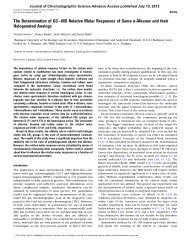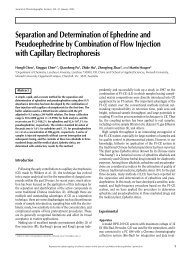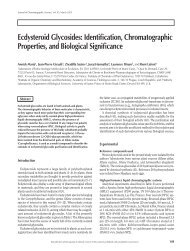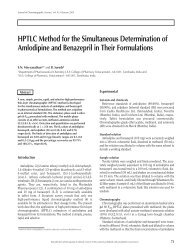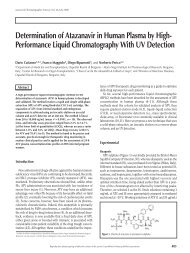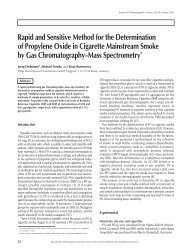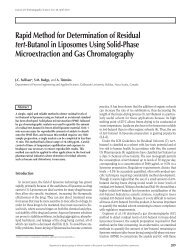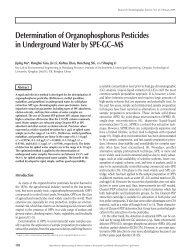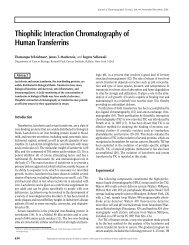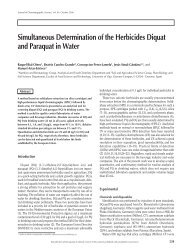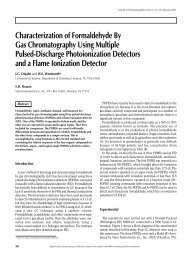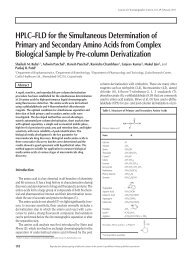Application of Convective Interaction Media (CIM®) Disk Monolithic ...
Application of Convective Interaction Media (CIM®) Disk Monolithic ...
Application of Convective Interaction Media (CIM®) Disk Monolithic ...
Create successful ePaper yourself
Turn your PDF publications into a flip-book with our unique Google optimized e-Paper software.
Journal <strong>of</strong> Chromatographic Science, Vol. 38, November 2000<br />
<strong>Application</strong> <strong>of</strong> <strong>Convective</strong> <strong>Interaction</strong> <strong>Media</strong><br />
(<strong>CIM®</strong>) <strong>Disk</strong> <strong>Monolithic</strong> Columns for Fast Separation and<br />
Monitoring <strong>of</strong> Organic Acids<br />
Martina Vodopivec 1<br />
, Aleš Podgornik 2,<br />
*, Marin Berovič 3<br />
, and Aleš Štrancar 2<br />
1<br />
National Institute <strong>of</strong> Chemistry, Hajdrihova 19, c; 2<br />
BIA Separations d.o.o., Teslova 30; and department <strong>of</strong> Chemical,<br />
Biochemical and Ecological Engineering, University <strong>of</strong> Ljubljana, Hajdrihova 19, SI-1000 Ljubljana, Slovenia<br />
Abstract<br />
The separation <strong>of</strong> organic acids on the anion-exchange monolithic<br />
support, commercially available as <strong>Convective</strong> <strong>Interaction</strong> <strong>Media</strong><br />
(CIM), is presented in this study. It is demonstrated that citric,<br />
isocitric, pyruvic, fumaric, malic, and α-ketoglutaric acid can be<br />
successfully separated using a CIM monolithic column <strong>of</strong> suitable<br />
user-adjustable length. The effect <strong>of</strong> the mobile phase composition<br />
on the separation is investigated. CIM monolithic columns <strong>of</strong><br />
adjustable length from 3 to 18 mm are compared<br />
regarding the resolution and the back pressure.<br />
It is shown that the CIM monolithic column <strong>of</strong><br />
12 mm in length enables a good separation <strong>of</strong> all<br />
six organic acids within 3 min and exhibits a linear<br />
dependence <strong>of</strong> back pressure versus flow rate.<br />
The resolution and the dynamic binding capacity<br />
are found to be flow-unaffected. A filtrated sample<br />
<strong>of</strong> bioprocess supernatant is analyzed without<br />
previous pretreatment, which indicates the<br />
possibility <strong>of</strong> online monitoring <strong>of</strong> small molecules<br />
during the bioprocess using CIM monolithic<br />
columns.<br />
Introduction<br />
Organic acids are the important metabolites <strong>of</strong><br />
several biochemical pathways in microorganisms<br />
and as a result they are frequently the main<br />
product or byproducts in different bioprocesses.<br />
One <strong>of</strong> organic acid's microbial producers is<br />
yeast (Yarrowia lipolytica), whose bioprocess<br />
represents an alternative to Aspergillus niger<br />
cultivation for citric acid production on an<br />
industrial scale (1).<br />
The production <strong>of</strong> citric acid involving Y.<br />
lipolytica is accompanied by the secretion <strong>of</strong><br />
smaller amounts <strong>of</strong> several other organic acids.<br />
From the point <strong>of</strong> view <strong>of</strong> a high production <strong>of</strong><br />
*Author to whom correspondence should be addressed:<br />
email ales.podgornik@guest.arnes.si.<br />
citric acid, the formation <strong>of</strong> these byproducts should be minimized.<br />
However, to understand the regulatory mechanisms governing<br />
the production <strong>of</strong> organic acids and consequently to<br />
optimize organic acid production as described above as well as in<br />
all similar bioprocesses, a rapid and simple method for monitoring<br />
these compounds is required.<br />
One <strong>of</strong> the most commonly used methods for organic acid<br />
determination is high-performance liquid chromatography<br />
(HPLC). By this method, carboxylic acids are separated usually<br />
Table I. Average Resolution Factors <strong>of</strong> Organic Acids (ΣR n_ n+1/5) and<br />
Retention Times <strong>of</strong> the Last Eluted Peak (t r) Obtained at Different<br />
Phosphate Buffer (c buffer) and NaCI (c NaC|) Concentrations in 20mM<br />
Phosphate Buffer on a CIM <strong>Monolithic</strong> Column <strong>of</strong> 12-mm length<br />
at 5-mL/min Flow Rate<br />
C buffer (mM) ΣR n-n+1/5 t r (min) c NaCl (mM) ΣR n-n+1/5 t r (min)<br />
500 0.53 (4*) 6.98 400 0.09 (3) 0.51<br />
400 0.65 (4) 7.01 300 0.23 (4) 0.73<br />
300 0.68 (4) 7.96 200 0.89 (5) 1.91<br />
200 0.79 (4) 10.28 150 1.71 (6) 4.29<br />
150 1.06 (5) 13.11 130 2.09 (6) 6.18<br />
100 1.47(5) 24.15 50 3.62 (6) 47.78<br />
* Number <strong>of</strong> separated peaks.<br />
Table II. Z Values and R 2<br />
Obtained from Linear Regression Analysis <strong>of</strong><br />
Organic Acid Retention Data, HETP Values for Organic Acids, and<br />
Values <strong>of</strong> Dynamic Binding Capacity for Organic Acids at Two Different<br />
Mobile Phase Flow Rates<br />
Capacity (mg <strong>of</strong><br />
organic acid per millileter)<br />
Organic acid Z factor (R 2<br />
) HETP (μm) 5 mL/min 10 mL/min<br />
Pyruvic acid (y= 1)* 1.01 (0.99) 48 1.0 1.0<br />
Malic acid (y = 2) 1.88 (0.99) 12 2.9 3.0<br />
Fumaric acid (y = 2) 1.96(0.99) 19 6.5 6.8<br />
α-Ketoglutaric acid (y = 2) 1.94 (0.99) 26 7.5 7.6<br />
Citric acid (y = 3) 3.04 (0.99) 26 10.2 10.4<br />
Isocitric acid (y = 3) 3.07 (0.99) 12.7 13.2<br />
* Valency <strong>of</strong> the acidic anion.<br />
Reproduction (photocopying) <strong>of</strong> editorial content <strong>of</strong> this journal is prohibited without publisher's permission. 489
y three different separation mechanisms such as anionexchange,<br />
ion-exclusion, or reversed-phase chromatography in<br />
which the separations are generally performed under isocratic<br />
flow conditions. In order to achieve satisfactory separation <strong>of</strong> different<br />
organic acid molecules, HPLC columns in length <strong>of</strong> 10 cm<br />
or more are typically used.<br />
In the last decade, several new chromatographic supports have<br />
been developed. One group (so called monoliths) exhibits several<br />
advantages over conventional chromatographic columns that<br />
are filled with porous particles. The main difference is in the exchanging<br />
process between the mobile and stationary phase. In the<br />
case <strong>of</strong> the monolithic macroporous matrix, this process is not<br />
limited by pore diffusion described thoroughly for conventional<br />
chromatographic material. The absence <strong>of</strong> the pore diffusion<br />
490<br />
Figure 1. The effect <strong>of</strong> the mobile phase composition (different NaCI concentrations in<br />
20mM phosphate buffer) on the resolution <strong>of</strong> the organic acid isocratic separation on a<br />
QA CIM column <strong>of</strong> 12-mm length: pyruvic acid (0.03-g/L sample), A; malic acid (0.5-g/L<br />
sample), B; α-ketoglutaric acid (0.2-g/L sample), C; fumaric acid (0.007-g/L sample), D;<br />
citric acid (2-g/L sample), E; and isocitric acid (2-g/L sample), F. Conditions: 400mM,<br />
200mM, and 130mM NaCI in 20mM phosphate buffer mobile phases; 5-ml/min flow<br />
rate.<br />
Figure 2. The effect <strong>of</strong> eluent concentration on the retention behavior <strong>of</strong> monovalent<br />
(y = 1), divalent (y = 2), and trivalent (y = 3) acidic ions.<br />
Journal <strong>of</strong> Chromatographic Science, Vol. 38, November 2000<br />
enables very short times for the separation process (2–4); flowunaffected<br />
resolution and dynamic binding capacity are<br />
advantages, also (5,6). Among the various monoliths, glycidyl<br />
metha- crylate-ethylene dimethacrylate (GMA-EDMA) monolithic<br />
macroporous media exhibit high mechanical and chemical<br />
stability (7) as well as low shrinking and swelling in different<br />
solvents or in the buffers <strong>of</strong> different ionic strengths (8).<br />
Besides the GMA-EDMA monolithic rods that are described<br />
extensively in literature (3,9), small-volume disk-shaped and<br />
large-volume tube-shaped GMA-EDMA monoliths are commercially<br />
available under the trademark <strong>Convective</strong> <strong>Interaction</strong><br />
<strong>Media</strong> (CIM). Bearing different active groups, CIM monolithic<br />
columns are used for separation mechanisms such as ionexchange,<br />
affinity, or hydrophobic interaction and are successfully<br />
applied for several separations <strong>of</strong> proteins<br />
(2,10-13). Actually, because their typical separation<br />
layer thickness is in a range <strong>of</strong> a few millimeters,<br />
the use <strong>of</strong> CIM monolithic columns were<br />
until the present time considered to be limited to<br />
the gradient separations <strong>of</strong> protein macromolecules.<br />
Recently, it has been shown that the same CIM<br />
disk monolithic columns can also be used for separations<br />
under isocratic flow conditions. The isocratic<br />
separations <strong>of</strong> plasmid DNA conformers<br />
(14), oligonucleotides (15,16), and peptides (16) in<br />
the ion-exchange mode have been demonstrated,<br />
and the isocratic reversed-phase separation <strong>of</strong><br />
steroid mixtures have been obtained (16). These<br />
results indicate the possibility <strong>of</strong> also applying<br />
CIM monoliths for the isocratic separation <strong>of</strong> several<br />
other small-charged molecules. Because the<br />
average analysis time using CIM disk monolithic<br />
columns is approximately 1-3 min, these supports<br />
can be a method <strong>of</strong> choice for the separation <strong>of</strong><br />
organic acids intended for in-process control.<br />
In this study, a simple method for the fast separation<br />
and monitoring <strong>of</strong> organic acids at room<br />
temperature is developed. Strong anion-exchange<br />
CIM quaternary amine (QA) disks commonly<br />
applied for efficient gradient separation <strong>of</strong> proteins<br />
were used, forming length-adjustable CIM<br />
monolithic columns. The effects <strong>of</strong> the mobile<br />
phase composition, flow rate, and column length<br />
on the quality <strong>of</strong> the separation were studied.<br />
Experimental<br />
Equipment<br />
An isocratic HPLC system included one HPLC<br />
Pump 64, an injection valve with a 20-μL sample<br />
loop, a variable wavelength ultraviolet-visible<br />
detector with a 10-μL volume flowcell (0.1-s<br />
response time), and a data-processing system. All<br />
<strong>of</strong> these instruments were obtained from Knauer<br />
(Berlin, Germany). All separations were carried
Journal <strong>of</strong> Chromatographic Science, Vol. 38, November 2000<br />
out at room temperature. The wavelength in all measurements<br />
was set to 210 nm. The flow rate was monitored by a validated<br />
digital flowmeter (K-3773, Phase Separation, UK).<br />
Separation unit<br />
Separations were performed on length-adjustable anionexchange<br />
CIM QA monolithic columns comprising <strong>of</strong> 1 to 6 CIM<br />
disks, all from BIA Separations (Ljubljana, Slovenia). The CIM<br />
disks were macroporous GMA-EDMA monolithic polymers<br />
bearing strong anion-exchange active groups (CIM QA disks).<br />
The diameter <strong>of</strong> a single CIM disk was 12 mm with a thickness <strong>of</strong><br />
3 mm. The length <strong>of</strong> the CIM monolithic column was varied by<br />
merging a different number <strong>of</strong> CIM disks in a<br />
single CIM housing.<br />
Mobile phase<br />
Double-deionized water purified with a Milli-Q<br />
system (Millipore, Bedford, MA) was used<br />
throughout. All chemicals were <strong>of</strong> analytical<br />
reagent grade. K 2HPO 4 and KH 2PO 4 were purchased<br />
from Kemika (Zagreb, Croatia) and NaCI<br />
from Fluka (Buchs, Switzerland). The mobile<br />
phase was prepared by dissolving a required<br />
amount <strong>of</strong> salt in the distilled water and<br />
adjusting the pH value to pH 8.0 with HC1.<br />
Sample<br />
Synthetic sample<br />
Citric, isocitric (three-sodium salt), pyruvic<br />
(sodium salt), and fumaric acid were supplied by<br />
Sigma (St. Louis, MO), and α-ketoglutaric (disodium<br />
salt) and malic acid were purchased<br />
from Fluka. All organic acid standards were <strong>of</strong><br />
analytical reagent grade. They were dissolved in<br />
a mobile phase, and afterwards, pH values were<br />
adjusted to pH 8.0.<br />
Bioprocess sample<br />
A sample <strong>of</strong> Y lipolytica fermentation broth<br />
that is described in detail elsewhere (17) was<br />
filtered through the 0.45-μm filter before<br />
injection.<br />
Results and Discussion<br />
The organic acids that were commonly<br />
secreted into the cultivation broth during the Y<br />
lipolytica bioprocess were pyruvic acid, citric<br />
acid (as the main product), and several other<br />
acidic metabolites <strong>of</strong> the Tricarboxylic acid<br />
(TCA)-cycle such as malic, fumaric, α-ketoglutaric,<br />
and isocitric acid (18). To obtain a complete<br />
picture <strong>of</strong> the organic acid composition in<br />
the cultivation broth, the possibility <strong>of</strong> separating all <strong>of</strong> the stated<br />
organic acids was studied with the intention <strong>of</strong> achieving optimal<br />
separation conditions regarding the mobile phase composition,<br />
thickness <strong>of</strong> the separation material, and mobile phase flow rate.<br />
In regards to the criteria for a quality separation, the average<br />
peak resolution (sum <strong>of</strong> all peak resolutions divided by the<br />
number <strong>of</strong> possible resolution values, which is 5) and analysis<br />
time were chosen. A resolution value greater than 2.0 was considered<br />
as satisfactory.<br />
Effect <strong>of</strong> the mobile phase composition<br />
The main difference between CIM and classical chromato-<br />
Table III. Average Resolution Factors <strong>of</strong> Organic Acids (ΣR n-n+1 /5<br />
and Retention Times <strong>of</strong> the Last Eluted Peak (t r) Obtained at Different<br />
CIM Column Lengths (L) at a 5-mL/min Flow Rate and at Different<br />
Mobile Phase Flow Rates on a CIM <strong>Monolithic</strong> Column <strong>of</strong> 12-mm Length<br />
L(mm) ΣR n-n+1 /5 t r (min)<br />
Flow rate<br />
(mL/min) ΣR n-n+1 /5 t r (min)<br />
3 0.57 (5)* 1.1 5.24 2.08 6.2<br />
6 0.83 (6) 2.51 7.58 2.0 4.33<br />
9 1.45 (6) 4.37 10.3 1.87 3.24<br />
12 2.09 (6) 6.18 15.3 1.57 2.19<br />
15 2.15(6) 8.69<br />
18 2.26 (6) 10.61<br />
* Number <strong>of</strong> separated peaks.<br />
Figure 3. The effect <strong>of</strong> the monolith thickness (number <strong>of</strong> CIM disks in the CIM housing)<br />
on the resolution <strong>of</strong> the organic acid isocratic separation: pyruvic acid (0.03-g/L sample),<br />
A; malic acid (0.5-g/L sample), B; α-ketoglutaric acid (0.2-g/L sample), C; fumaric acid<br />
(0.007-g/L sample), D; citric acid (2-g/L sample), E; and isocitric acid (2-g/L sample), F.<br />
Conditions: 130mM NaCI in 20mM phosphate buffer mobile phase, CIM disk monolithic<br />
column separation unit comprising <strong>of</strong> 1-6 QA CIM disks; 5-mL7min flow rate.<br />
491
graphic support is that <strong>of</strong> a hydrodynamic nature; the surface<br />
chemistry is equal for both. Therefore, a starting method for<br />
organic acid separation was taken from literature (19) using<br />
phosphate buffer as a mobile phase. In Table I, the equated resolutions<br />
and retention times <strong>of</strong> the final eluted peak at different<br />
phosphate buffer compositions are presented. By changing the<br />
mobile phase concentration from higher to lower values, resolution<br />
improved. However, this prolonged the analysis time. Still,<br />
even at the lowest buffer concentration <strong>of</strong> lOOmM, we were not<br />
able to separate all six organic acids when having the analysis<br />
time close to 24 min at a mobile phase flow rate <strong>of</strong> 5 mL/min.<br />
To obtain improvement in the resolution, a major part <strong>of</strong> the<br />
phosphate buffer was replaced with NaCl. In Figure 1, chromatograms<br />
<strong>of</strong> organic acid separations at three different NaCl<br />
concentrations (400mM, 200mM, and 130mM) in 20mM phosphate<br />
buffer are presented. From these chromatograms as well as<br />
from Table I, it is evident that lowering the NaCl concentration<br />
has the same effect on the resolution and analysis time as<br />
described for pure phosphate buffer. However, in this case, the<br />
resolution drastically improved reaching the resolution value <strong>of</strong><br />
492<br />
Table IV. Parameters <strong>of</strong> Linearity and Limit <strong>of</strong> Detection for the<br />
Separation <strong>of</strong> Pyruvic, Malic, α-Ketoglutaric, Fumaric, Citric,<br />
and Isocitric Acid on CIM <strong>Monolithic</strong> Columns <strong>of</strong> 12-mm Lengths<br />
Upper linear<br />
Limit <strong>of</strong> concentration<br />
Organic acid Detection (g/L) value (g/L) R 2<br />
Slope Intercept<br />
Pyruvic acid 0.0005 4 0.9997 49.987 -3.0046<br />
Malic acid 0.0076 6 0.9984 3.6872 0.2037<br />
Fumaric acid 0.00047 0.2 0.9998 558.63 -0.2519<br />
α-Ketoglutaric acid 0.0031 4 0.9999 39.33 0.2112<br />
Citric acid 0.0313 15 0.9997 3.8999 0.3142<br />
Isocitric acid 0.0305 20 0.9998 3.3749 -0.0167<br />
Figure 4. The effect <strong>of</strong> flow rate on the organic acid isocratic separation on the QA CIM<br />
monolithic column <strong>of</strong> 12-mm length: pyruvic acid (0.03-g/L sample), A; malic acid (0.5-<br />
g/L sample), B; α-ketoglutaric acid (0.2-g/L sample), C; fumaric acid (0.007-g/L sample),<br />
D; citric acid (2-g/L sample), E; and isocitric acid (2-g/L sample), F. Conditions: 130mM<br />
NaCl in 20mM phosphate buffer mobile phase; 5.24-, 7.58-, 10.3-, and 15.3-mL/min flow<br />
rates.<br />
Journal <strong>of</strong> Chromatographic Science, Vol. 38, November 2000<br />
3.62 at the displacer salt concentration <strong>of</strong> 50mM NaCl. Because<br />
the analysis time exceeded 45 min at a flow rate <strong>of</strong> 5 mL/min, we<br />
chose the mobile phase concentration <strong>of</strong> 130mM NaCl in 20mM<br />
phosphate buffer as an optimal mobile phase having the analysis<br />
time at approximately 8 min (Figure 1). This mobile phase was<br />
used for all further organic acid separations.<br />
To improve the understanding <strong>of</strong> organic acid retention properties<br />
at different NaCl concentrations, we calculated the capacity<br />
factors (k')-<strong>of</strong> the carboxylate analytes and correlated the log k'<br />
values as the function <strong>of</strong> log C eluent (Figure 2). As can already be<br />
concluded from Figure 1, changes in the eluent concentration<br />
had a significant effect on the analyte retention characteristics.<br />
Increasing the NaCl concentration led to decreased capacity<br />
factors. However, the capacity factors decreased differently for<br />
each group <strong>of</strong> acidic anions with certain valencies resulting in<br />
an intersection <strong>of</strong> some lines. Consequently, as it has already<br />
been described in literature (20), by changing the eluent concentration,<br />
the elution order <strong>of</strong> organic acids could be reversed.<br />
However, in the eluent concentration range in which the<br />
separation <strong>of</strong> all six organic acids was achieved, the elution order<br />
did not change.<br />
For the further understanding <strong>of</strong> retention<br />
behavior, Z factors were determined from the<br />
slopes <strong>of</strong> the plots shown in Figure 2. From Table<br />
II, it is evident that Z factors increased with the<br />
increasing valency <strong>of</strong> the acidic anions. Z factors<br />
for tricarboxylate citrate and isocitrate were<br />
higher than Z factors for dicarboxylate malate, αketoglutarate,<br />
and fumarate and higher than the Z<br />
factor for monocarboxylate pyruvate anions,<br />
which had the lowest value. This is sensible<br />
because at the described elution conditions, all<br />
organic acids were fully dissociated. Thus, with<br />
the increase <strong>of</strong> acidic anion valency, the number <strong>of</strong><br />
binding sites also increased and as a consequence<br />
more eluent was needed to solvate the anions.<br />
Moreover, Z factors were practically equal to the<br />
valency <strong>of</strong> the acidic anions for the organic acids <strong>of</strong><br />
all three valencies that were obtained together<br />
with high correlation coefficients (R 2<br />
) for the<br />
linear regression analysis <strong>of</strong> data in agreement<br />
with a dominant ion-exchange chromatography<br />
(IEC) elution mode. From these results, it can be<br />
concluded that the retention was mainly the consequence<br />
<strong>of</strong> IEC effects (21).<br />
To compare the efficiency <strong>of</strong> CIM monolithic<br />
columns with the efficiency <strong>of</strong> other columns<br />
used for organic acid separations, high equivalent<br />
to the theoretical plate (HETP) values for all six<br />
organic acids were estimated (Table II). Thus, the<br />
HETP value <strong>of</strong> malic acid for a CIM disk column<br />
was 12 μm, which was approximately twice less<br />
than the HETP value <strong>of</strong> the same acid for Aminex<br />
column HPX-87H, estimated to be 25 μm (22). As<br />
a result, CIM columns had higher efficiency providing<br />
the possibility <strong>of</strong> performing separations on<br />
shorter separation layers.
Journal <strong>of</strong> Chromatographic Science, Vol. 38, November 2000<br />
Effect <strong>of</strong> the thickness <strong>of</strong> the separation layer<br />
The length <strong>of</strong> the column is another parameter that affects the<br />
peak resolution in the isocratic mode, because a longer length <strong>of</strong><br />
the separation material increases the number <strong>of</strong> theoretical<br />
plates. CIM monolithic columns <strong>of</strong>fer a unique possibility to vary<br />
a column length by placing different numbers <strong>of</strong> the CIM disks<br />
into a single CIM housing. This can be done by the user simply by<br />
opening a CIM housing and inserting the desired number <strong>of</strong> CIM<br />
disks. In this way, the total column length is a sum <strong>of</strong> the number<br />
<strong>of</strong> CIM disks placed in the CIM housing multiplied by the thickness<br />
<strong>of</strong> the CIM disk. It has already been shown in the case <strong>of</strong> isocratic<br />
separation <strong>of</strong> oligonucleotides that separation on the CIM<br />
monolithic column is improved significantly by increasing its<br />
length, which exhibits no distortion <strong>of</strong> the peak shape or resolution<br />
because <strong>of</strong> a discontinued bed (15). Chromatograms in<br />
Figure 3 show the same tendency also in the case <strong>of</strong> organic acid<br />
separation. The average resolutions equated from these chromatograms<br />
are shown in Table III.<br />
The CIM monolithic column <strong>of</strong> length 3 mm (a single CIM disk)<br />
was not able to separate all six acids. Its average resolution was<br />
only 0.57. By placing two CIM disks in the CIM housing, a CIM<br />
monolithic column <strong>of</strong> 6 mm length was obtained, and it can be<br />
further extended to the length <strong>of</strong> 18 mm using 6 CIM disks in a<br />
single CIM housing. The resolution increased each time<br />
(reaching the maximal value <strong>of</strong> 2.26). Of course, a longer separation<br />
layer resulted in a longer analysis time (Table III) and higher<br />
back pressure. The relationship between the analysis time and<br />
separation layer thickness was linear with a correlation coefficient<br />
<strong>of</strong> 0.9935. Furthermore, it was also found that the back<br />
pressure changed linearly with the CIM column length resulting<br />
in a correlation coefficient <strong>of</strong> 0.9913. However, even at the<br />
longest CIM monolithic column, the back pressure was still moderate<br />
(reaching only 1.4 MPa at the flow rate <strong>of</strong> 5 mL/min).<br />
Effect <strong>of</strong> the flow rate<br />
It has been shown that in contrast to the conventional<br />
particle chromatographic material, the<br />
resolution achieved in CIM monoliths is not<br />
affected by the flow rate <strong>of</strong> the mobile phase neither<br />
in a gradient (8) nor isocratic mode (15). In<br />
contrast to the previous studies carried out on a<br />
single CIM disk, the CIM disk monolithic column<br />
<strong>of</strong> 12 mm (built up <strong>of</strong> four CIM disks) was used to<br />
investigate the effect <strong>of</strong> the flow rate on the isocratic<br />
separation <strong>of</strong> organic acids. Data in Table III<br />
exhibit a decreasing <strong>of</strong> the average resolution with<br />
increasing flow rate; although at the highest<br />
mobile phase flow rate <strong>of</strong> 15.3 mL/min, the<br />
average resolution was still above 1.5. However,<br />
this tendency in the resolution proved to be in a<br />
high degree accountable to the HPLC system<br />
itself. Namely, data-recording time intervals <strong>of</strong> the<br />
system were too large, which at high flow rates<br />
apparently causes a decrease <strong>of</strong> peak heights while<br />
the peaks in all cases still remain well-separated.<br />
This can be seen in Figure 4 in which the comparison<br />
<strong>of</strong> the chromatograms normalized on the<br />
elution volume obtained at 5.24, 7.58,10.3, and<br />
15.3 mL/min is presented.<br />
The main advantage <strong>of</strong> working at high flow rates is certainly a<br />
shorter analysis time, which means great time savings in eventual<br />
downstream processes. As it is evident from Table III, the<br />
retention time <strong>of</strong> the last peak was shortened from approximately<br />
6 min to approximately 2 min when the flow rate was increased<br />
from 5 to 15 mL/min. However, the applicability <strong>of</strong> chromatographic<br />
material for the purification <strong>of</strong> molecules on a preparative<br />
scale is largely conditioned by a high binding capacity <strong>of</strong> the<br />
material. Because dynamic binding capacities for CIM monolithic<br />
columns that are measured for proteins reach relatively high<br />
values (25-30 mg <strong>of</strong> protein per milliliter) (5), we examined them<br />
also for organic acids. As evident from Table II, dynamic binding<br />
capacities are dependent on the specific organic acid employed<br />
and increase with the valency <strong>of</strong> the organic acid (ranging<br />
between 1 and 13 mg <strong>of</strong> organic acid per milliliter). Furthermore,<br />
measuring the dynamic capacities at two different mobile phase<br />
flow rates showed that they were unaffected by the flow rate,<br />
which was in contrast to the dynamic capacities <strong>of</strong> conventional<br />
chromatographic materials. However, the flow-unaffected<br />
binding capacity characteristic <strong>of</strong> CIM monolithic columns has<br />
already been presented in the case <strong>of</strong> proteins (5,8). This important<br />
feature <strong>of</strong> CIM material enables the performance <strong>of</strong> organic<br />
acid separations at higher flow rates without loosing binding<br />
capacity and quality <strong>of</strong> separation, thus opening the possibility <strong>of</strong><br />
the application <strong>of</strong> CIM monoliths for the eventual purification <strong>of</strong><br />
organic acids from cultivation broths.<br />
However, when working at high flow rates, the limiting factor is<br />
the back pressure <strong>of</strong> the CIM column. Similar to the linear relation<br />
between the flow rate and the back pressure found for a<br />
single CIM disk monolithic column (8), the same relationship<br />
was found for a CIM disk monolithic column containing several<br />
CIM disks. Thus, this feature seems to be common for all CIM<br />
Figure 5. Analysis <strong>of</strong> organic acids in the Y. lipolytica cultivation broth using the QA CIM<br />
monolithic column <strong>of</strong> 12-mm length: unidentified peak, A; pyruvic acid, B; malic acid, C;<br />
α-ketoglutaric acid, D; fumaric acid, E; and citric acid, F. Conditions: 130mM NaCI in<br />
20mM phosphate buffer mobile phase; 17-mL/min flow rate.<br />
493
disk monolithic columns. Therefore, one can easily estimate the<br />
characteristics <strong>of</strong> a particular CIM disk monolithic column that<br />
facilitate its application.<br />
Detection <strong>of</strong> organic acids in cultivation broth<br />
The quantities <strong>of</strong> organic acids that accumulate in a Y. lipolytica<br />
cultivation broth are different; besides, they depend on the composition<br />
<strong>of</strong> the cultivation medium as well as cultivation conditions.<br />
Citric acid as the main product accumulates in the<br />
cultivation broth in the highest concentration (which is approximately<br />
10 g/L at the end <strong>of</strong> the batch process), whereas concentrations<br />
<strong>of</strong> other organic acids are only a few grams per liter (23).<br />
To examine the possibility <strong>of</strong> the application <strong>of</strong> the method using<br />
the QA CIM column for organic acid detection in the concentration<br />
ranges that appear in the real samples, we determined the<br />
range <strong>of</strong> linearity as well as the limit <strong>of</strong> detection for each acid.<br />
In determining the linearity <strong>of</strong> the method, different concentrations<br />
<strong>of</strong> organic acids were injected. The parameters <strong>of</strong> the calibration<br />
curves for each acid are summarized in Table IV. The high<br />
values for R 2<br />
showed good method linearity. Typically, the linear<br />
range is <strong>of</strong> three orders <strong>of</strong> magnitude and is <strong>of</strong> course dependent<br />
on the injection loop volume. The detection limit was considered<br />
as the concentration at which the signal-to-noise ratio <strong>of</strong> more<br />
than 10 was obtained. Because in this case a loop <strong>of</strong> 20 μL was<br />
used, a detection limit could be further lowered using a larger<br />
volume injection loop. However, when samples <strong>of</strong> high organic<br />
acid concentrations are to be analyzed, the samples should be<br />
diluted before analysis in order to fall in the linear range <strong>of</strong> the<br />
method.<br />
To verify the method, we investigated the efficiency <strong>of</strong> the CIM<br />
QA support when real samples were applied. The sample <strong>of</strong> Y<br />
lipolytica bioprocess broth was used. It is important to emphasize<br />
that no dialysis or any other pretreatment <strong>of</strong> the sample except a<br />
filtration was performed. This approach has already been successfully<br />
used for the analysis <strong>of</strong> lignin peroxidase is<strong>of</strong>orms (24). The<br />
feature is supposedly because <strong>of</strong> the high group density, which<br />
results in a significant capacity in the presence <strong>of</strong> salt (5). In<br />
Figure 5, the separation <strong>of</strong> the TCA-cycle acids and pyruvic acid in<br />
the broth using a QA CIM disk monolithic column <strong>of</strong> 12 mm<br />
length at a flow rate <strong>of</strong> 17 mL/min is presented. As can be concluded<br />
from the chromatogram, no isocitric acid was present in<br />
the sample. The first unretained peak was a sum <strong>of</strong> the broth components<br />
that did not bind to the anion-exchange material and did<br />
not interfere with the analysis. The whole separation was performed<br />
in 2 min. Even at so high <strong>of</strong> a flow rate, the back pressure<br />
<strong>of</strong> the complete HPLC system was only 10 MPa. Therefore, it can<br />
be concluded that CIM chromatography can be a method <strong>of</strong><br />
choice for the separation <strong>of</strong> organic acids whenever fast analysis<br />
without sample pretreatment is required.<br />
Conclusion<br />
CIM ion-exchange monolithic columns demonstrated to be an<br />
efficient medium for the fast separation <strong>of</strong> large molecules (and<br />
recently for smaller molecules such as peptides and oligonucleotides,<br />
also). A successful separation <strong>of</strong> organic acids further<br />
494<br />
Journal <strong>of</strong> Chromatographic Science, Vol. 38, November 2000<br />
enlarges this set to even smaller highly charged molecules. The<br />
unique possibility to adopt a CIM disk monolithic column length<br />
by a user to match particular system requirements makes these<br />
supports attractive for many different applications. This feature<br />
(combined with a relatively low back pressure and a practically<br />
flow-unaffected resolution and dynamic binding capacity) <strong>of</strong>fers<br />
more possibilities for a method optimization in regards to the<br />
separation and speed. However, the possibility <strong>of</strong> analysis directly<br />
from fermentation broth without a particular pretreatment indicates<br />
the possible application <strong>of</strong> CIM columns as a multipurpose<br />
sensor with a short response time.<br />
References<br />
1. M. Mattey. The production <strong>of</strong> organic acids. Crit. Rev. Biotechnol.<br />
12:87-132 (1992).<br />
2. A. Štrancar, P. Koselj, H. Schwinn, and D. Josič. <strong>Application</strong> <strong>of</strong> compact<br />
porous disks for fast separation <strong>of</strong> biopolymers and in-process<br />
control in biotechnology. Anal. Chem. 68:3483-88 (1996).<br />
3. F. Švec and J.M.J. Frechet. New design <strong>of</strong> macroporous polymers<br />
and supports: from separation to biocatalysis. Science273:205-211<br />
(1996).<br />
4. K. Cabrera, D. Lubda, H.M. Eggenweiler, H.M. Minakuchi, and<br />
K. Nakanishi. A new monolithic-type HPLC column for fast separations.<br />
J. High Res. Chromatogr. 23:93-99 (2000).<br />
5. I. Mihelič, Τ. Koloini, A. Podgornik, and A. Štrancar. Dynamic<br />
capacity studies <strong>of</strong> CIM (<strong>Convective</strong> <strong>Interaction</strong> <strong>Media</strong>) monolithic<br />
columns.High Resol. Chromatogr. 23:39-43 (2000).<br />
6. G. Iberer, R. Hahn, and A. Jungbauer. Monoliths as stationary phases<br />
for separating biopolymers—fourth generation <strong>of</strong> chromatography<br />
sorbents. LC-GC17:998-1005 (1999).<br />
7. T.B. Tennikova, M. Bleha, F. Švec, T.V. Almazova, and B.G. Belenkii.<br />
High performance chromatography <strong>of</strong> proteins, a novel method <strong>of</strong><br />
protein separation. J. Chromatogr. 555:97-107 (1991).<br />
8. A. Štrancar, Μ. Barut, A. Podgornik, A. Buchaher, and D. Josić.<br />
<strong>Convective</strong> <strong>Interaction</strong> <strong>Media</strong>: polymer based supports for fast<br />
separation <strong>of</strong> biomolecules. LC-GC 11:660-669 (1998).<br />
9. F. Švec and J.M.J. Frechet. Continuous rods <strong>of</strong> macroporous polymer<br />
as high performance liquid chromatography separation media.<br />
Anal. Chem. 64:820-822 (1992).<br />
10. D. Josić J. Reusch, K. LÖster, O. Baum, and W. Reutter. High performance<br />
membrane chromatography <strong>of</strong> serum and plasma membrane<br />
proteins. J. Chromatogr. 590:59-76 (1992).<br />
11. T.B. Tennikova and F. Švec. High performance membrane chromatography:<br />
highly efficient separation method for proteins in ionexchange,<br />
hydrophobic interaction and reversed-phase modes.<br />
J. Chromatogr. 646:279-38 (1993).<br />
12. J. Lukša. V. Menart, S. Miličić , Β. Kus, V. Gaberc-Porekar, and<br />
D. Josič. Purification <strong>of</strong> human tumor necrosis factor by membrane<br />
chromatography. J. Chromatogr. A 661:161 -68 (1994).<br />
13. D. Josić, Η. Schwinn, A. Štrancar, A. Podgornik, M. Barut, Y.-P. Lim,<br />
and M. Vodopivec. Use <strong>of</strong> compact porous units with immobilised<br />
ligands with high molecular masses in affinity chromatography and<br />
enzymatic conversion <strong>of</strong> substrates with high and low molecular<br />
masses. J. Chromatogr. A 803:61-71 (1998).<br />
14. R. Giovannini, R. Freitag, and T. Tennikova. High performance<br />
membrane chromatography <strong>of</strong> supercoiled plasmid DNA. Anal.<br />
Chem. 70:3348-54 (1998).<br />
15. A. Podgornik, M. Barut, J. Jančar, and A. Štrancar. Isocratic separations<br />
on thin glycidyl methacrylate-ethylenedimethacrylate monoliths.<br />
J. Chromatogr. A 848:51-60 (1999).<br />
16. A. Podgornik, M. Barut, J. Jančar, A. Štrancar, and T. Tennikova.<br />
High-performance membrane chromatography <strong>of</strong> small molecules.<br />
Anal. Chem. 71:2986-91 (1999).
Journal <strong>of</strong> Chromatographic Science, Vol. 38, November 2000<br />
17. K.D. Rane and A. Sims. Production <strong>of</strong> citric acid by Candida lipolytica<br />
Y1095: effect <strong>of</strong> glucose concentration on yield and production.<br />
Enzyme Micro. Technol. 15:646-51 (1993).<br />
18. I.A. McKay, I.S. Maddox, and J.D. Brooks. High specific rates <strong>of</strong><br />
glucose utilisation under conditions <strong>of</strong> restricted growth are<br />
required for citric acid accumulation by Yarrowia lipolytica IMK 2.<br />
Appl. Microbiol. Biotechnol. 41:73-78 (1994).<br />
19. M. Gey, B. Nagel, E. Weissbrodt, and U. Stottmeister. Fast liquid<br />
chromatographic determination <strong>of</strong> organic acids in fermentation<br />
media with short glass columns. Anal. Chim. Acta 213: 227-230<br />
(1988).<br />
20. P. Hajós and L. Nagy. Retention behaviours and separation <strong>of</strong> carboxylic<br />
acids by ion-exchange chromatography. J. Chromatogr. Β<br />
717:27-38 (1998).<br />
21. G. Révész, P. Hajós, and H. Csiszár. Mixed-mode liquid chromatography<br />
<strong>of</strong> carboxylic acids and inorganic anions on a latexbased<br />
pelliculat stationary phase. J. Chromatogr. A 753: 253-260<br />
(1996).<br />
22. Bio-Rad Life Science Research Products Catalogue (1998/99). p 47.<br />
23. Μ. Moresi. Effect <strong>of</strong> glucose concentration on citric acid production<br />
by Yarrowia lipolytica. J. Chem. Tech. Biotechnol. 60:387-95<br />
(1994).<br />
24. H. Podgornik, A. Podgornik, and A. Perdih. A method <strong>of</strong> fast<br />
separation <strong>of</strong> lignin peroxidases using CIM (<strong>Convective</strong> <strong>Interaction</strong><br />
<strong>Media</strong>) disks. Anal. Biochem. 272:43–7 (1999).<br />
Manuscript accepted June 29, 2000.<br />
495



